#prosauropods
Text
Prosauropods sure know how to party!
#remember when we all had to draw these for adad because that was a trip#dinosaurs#palaeoblr#prosauropods#plateosaurus#sauropods#massospondylus#mussaurus#anchisaurus#eoraptor
65 notes
·
View notes
Text

drawing of a plateosaurus soldier
#drawing#sketch#digital art#digital drawing#anthro#furry#furry art#anthro art#dinosaur#saurian#triassic#plateosaurus#plateosauridae#prosauropod#fantasy art#soldier#dynasoar5#ssohardd
194 notes
·
View notes
Text
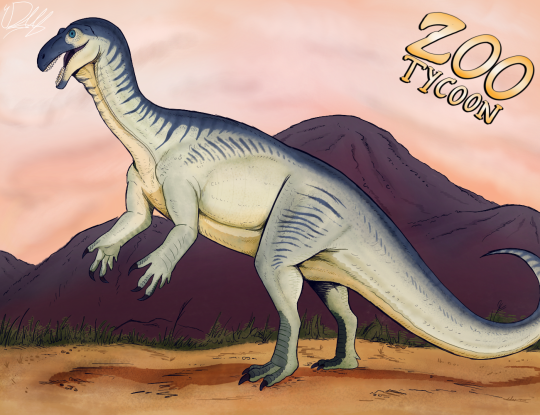
Artwork of the Plateosaurus from the Zoo Tycoon: Dinosaur Digs DLC.
It's a very primitive sauropod relative from the Triassic Period and was considered one of the largest dinosaurs of that era. Its bipedal stance contrasts the appearance of its eventual sauropod descedants.
#art#artwork#artists on tumblr#colorful#dinosaur#paleoart#paleoillustration#animal#zoo#zoo tycoon#saurischia#prosauropod#plateosaurus#sauropod#triassic#mesozoic#prehistoric#dinosaurs
85 notes
·
View notes
Text
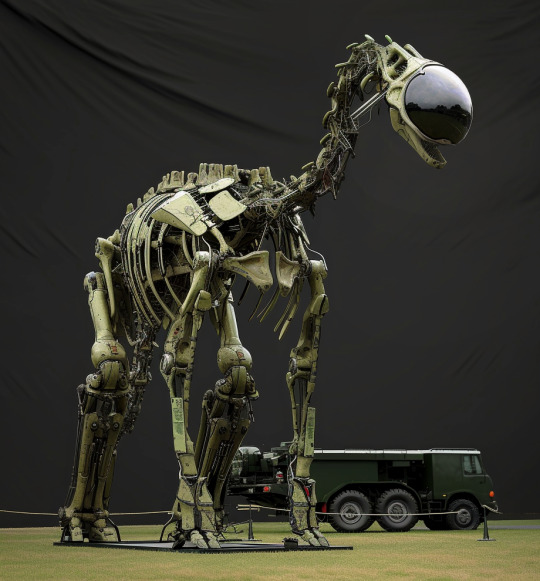
Clandestine defense expo snapshot—proof-of-concept technology demonstrator for a mid-size quadrupedal sauropodiform military cyborg chassis adapted to functional mobility in special operations on high-g worlds (presumably, those already populated by sauropodomorph dinosauriforms, sapient or otherwise).

Skeleton of a prosauropodomorph combat 'borg being prepared for display at the Cybernetic War Museum. Lots of controversy about whether it's appropriate to treat the remains of cyborg veterans like this, even if the actual soldiers survived and have since been transplanted into civilian chassis.
Midjourney V6
#ai cyborgs#sauropods and prosauropods#brachiosaurus and plateosaurus#extrasolar combat#cybernetic warfare
21 notes
·
View notes
Text
It Came From The Trash Heap (We Don't Talk About Kholumolumo)
A wastebasket taxon is what happens when species can't be easily classified and instead get hurled into a "catch-all" category.
…But that's not the only kind of taxonomic tangle that can befall a new discovery.
When a scientific name is assigned to a new species, but it isn't given a corresponding formal description and type specimen, it becomes a nomen nudum – a "naked name". Without a proper description and assigned holotype the name isn't valid, and the new species isn't technically accepted by the wider scientific community.
This has even happened to some surprisingly famous names. In the 1920s Velociraptor mongoliensis was briefly given the nomen nudum "Ovoraptor djadochtari" before getting its much more familiar name when it was officially described. Meanwhile the giant pterosaur Quetzalcoatlus northropi was stuck as a nomen nudum for decades, only finally getting a proper published description in 2021.
And there's another particular long-standing nomen nudum that became mildly infamous – "Thotobolosaurus", the "trash heap lizard".
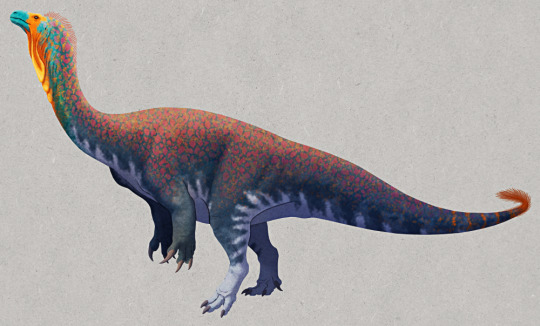
Discovered next to a literal trash pile in the village of Maphutseng in Lesotho, a few scattered and broken bones of this "prosauropod" sauropodomorph dinosaur were first found in 1930. But it wasn't until the mid-1950s that a more extensive bonebed began to be unearthed at the site, and over the next decade over 1000 fossil fragments were collected.
In the mid-1960s the remains were initially classified as belonging to Euskelosaurus browni (which is now considered to be a wastebasket taxon), but just a few years later in 1970 the "Maphutseng Beast" was re-evaluated as a species new to science. It was referred to as "Thotobolosaurus mabeatae" – based on the local name of the discovery site, "Thotobolo ea ‘Ma-Beata" (trash heap of Beata’s mother) – but this name was never actually formally published.
Despite "Thotobolosaurus" being an undescribed nomen nudum it nonetheless went on to be repeatedly referenced in scientific literature over the next few decades, and appeared in several popular dinosaur books (even as recently as 2020!).
In the mid-1990s it was alternatively named "Kholumolumosaurus ellenbergerorum" in a Ph.D. dissertation, with this name derived from the kholumolumo, a reptilian creature in Sotho mythology, and the Ellenberger brothers who worked on the site. But this also didn't count as a formal publication and instead became a second nomen nudum for the species.
Eventually, 90 years after the first bones were found and 50 years after the debut of the name "Thotobolosaurus", this long-neglected sauropodomorph was finally given a proper published full anatomical description in 2020.
And it also got a third name, this time officially valid, based on the second one from the 1990s: Kholumolumo ellenbergerorum.
For something associated with trash for so long, Kholumolumo is actually now one of the most completely-known prosauropods. At least five different individuals were present in the collected fossil material, possibly as many as ten, and between them most of the full skeleton is represented – with the exception of the skulls, which are only known from a couple of small fragments.
We now know Kholumolumo was rather heavily-built, with chunky limb bones and unusually short shinbones. It would have been one of the biggest animals around in the Late Triassic (~210 million years ago), measuring at least 9m long (~30') and weighing around 1.7 tonnes (1.9 US tons), but despite its size it seems to have still been bipedal.
Due to the highly disarticulated nature of the bones the fossil site may have been a "bone accumulation area", a place where dismembered bits and pieces of different carcasses were regularly carried to be eaten by a predator or scavenger – essentially a trash heap, fittingly enough. A couple of "rauisuchian" teeth have actually been found among the remains, which might indicate what was chomping on these particular Kholumolumo.
———
Nix Illustration | Tumblr | Twitter | Patreon
#it came from the wastebasket#nomen nudum#taxonomy#kholumolumo#thotobolosaurus#prosauropod#massopoda#sauropodomorpha#dinosaur#paleontology#art#science illustration#paleoart#palaeoblr
290 notes
·
View notes
Text

Plateosaurus.
#art#digital art#illustration#paleo#palaeoblr#paleoart#prehistoric#dino#dinosaur#dinosaurs#reptile#prosauropod#sauropodomorpha#plateosaurus#plateosaurid#extinct#extinct animals#archosaur#dinovember#dinovember2022#it looks kinda bad because i rushed it a bit sorry
168 notes
·
View notes
Note
Did the very early sauropodomorphs have feathers?
I would say it is highly likely that they did! We currently have no direct evidence for or against feathers or scales on early sauropodomorphs, which means we have to rely on our understanding of other species.
We know that theropods and ornithischians posessed feathery structures at some point in their evolutionary history, and we know that pterosaurs were also fuzzy! There's actually new research that indicates pterosaur fluff does in fact share a common ancestor with dinosaur fluff, meaning all dinosaurs and pterosaurs are most likely descended from a feathered ancestor.
So what does this mean for sauropodomorphs? Well, given the earliest dinosaur was most likely feathered, early sauropodomorphs probably inherited their fluff! They were still small and vulnerable in the Triassic, and a fluffy coat like I've given this Thecodontosaurus would have helped them survive.

Image ID: Digital illustration of Thecodontosaurus, a small early sauropodomorph. It is a slender bipedal dinosaur, with a long tail and long, clawed arms. Its body is partially covered with a coat of feathers, except for the head and neck, which have bare, wrinkled skin like a turkey. The legs and belly are also bare, and coloured a pale brown. The feathers are dark brown, with white stripes on the quill-like feathers at the base of the tail. The head is mottled grey and yellow, with a blue face and red eye. Its body is turned towards the viewer, with one foot raised in an active pose. End ID.
However, as sauropodomorphs grew larger they probably outgrew their fluffy coats, as they would provide less protection than their large size already did and a heavy coat would risk overheating. Larger sauropodomorphs, such as the early Jurassic Lufengosaurus, may have had a few residual areas of fuzzy skin like today's giant mammals, but were probably scaly overall.

Image ID: Digital illustration of Lufengosaurus, a large bipedal sauropodomorph with a long neck and heavy torso and tail. The skin is scaly, except for a light dusting of feathers on the back and underside of the neck. Its body is light grey with darker spots on the back and light stripes on the tail. The neck fades to orange towards the small head, which is coloured a dark brown. The Lufengosaurus is in a walking pose, with both feet on the ground. End ID.
One thing we do know from skin imprints, is that later sauropods like Camarasaurus were definitely scaly. So at some point in their evolution, sauropodomorphs lost their feathers.
#dinosaurs#paleontology#paleoart#palaeoblr#sauropods#thecodontosaurus#lufengosaurus#prosauropod#triassic#jurassic#my art#prehistoric#fossils
193 notes
·
View notes
Text

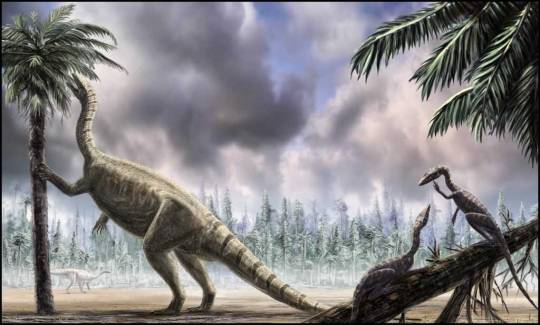
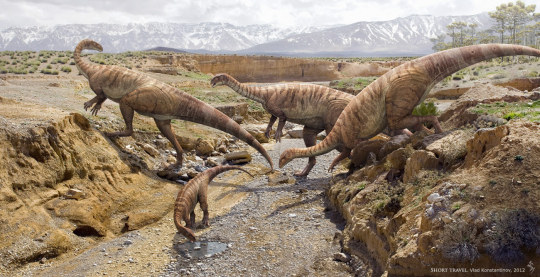
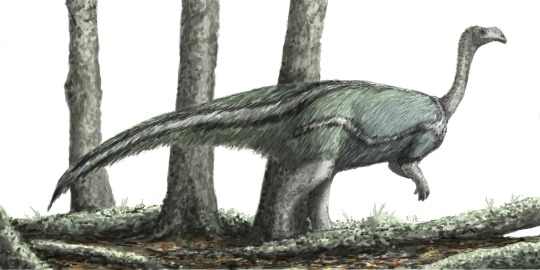
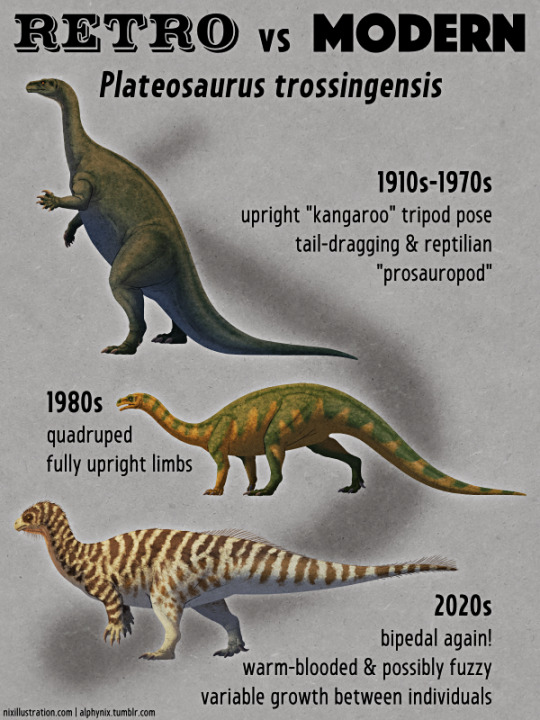
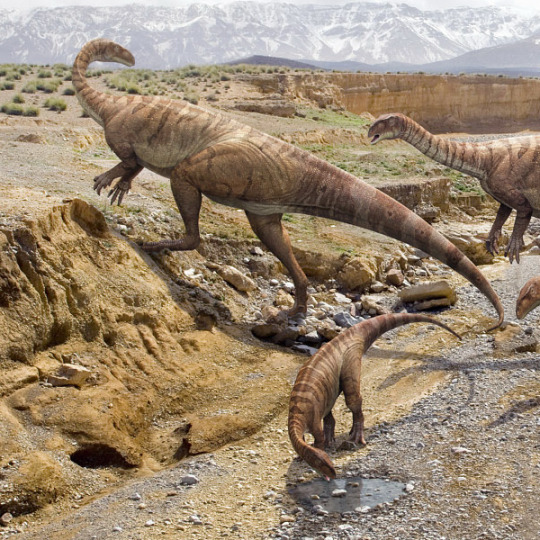




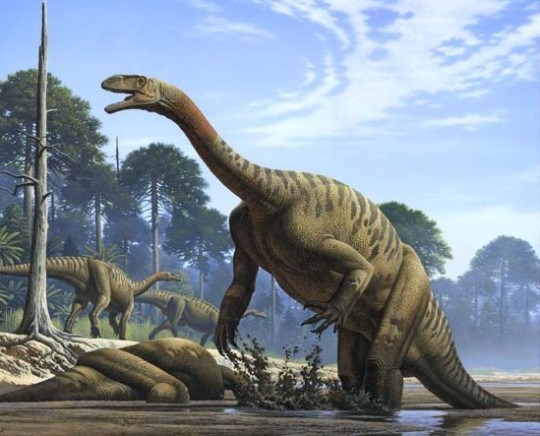
Plateosaurus is a genus of basal early sauropodomorph dinosaur aka a prosauropod, which lived throughout what is now Europe and possibly Greenland from the Norian to the Rhaetian of the late triassic some 214 to 204 million years ago. The first remains now known to belong to Plateosaurus consisted of parts of the legs and some vertebrae were unearthed in 1834 by physician Johann Friedrich Engelhardt at Heroldsberg near Nuremberg, Germany. He then showed them to palaeontologist Hermann von Meyer, who in 1837 designated them as Plateosaurus meaning broad lizard. This means that Plateosaurus is the fifth named dinosaur genus that is still considered valid. Since then the remains of well over 100 individuals have been recovered throughout Switzerland, France, Norway, and especially the German region of Swabia causing German palaeontologist Friedrich August von Quenstedt to nickname the animal Schwäbischer Lindwurm meaning the Swabian Dragon. Material referred to Plateosaurus has also been found in the Fleming Fjord Formation of East Greenland, however much of these remains have now been assigned to its own distinct genus of prosauropod called Issi. Although there remains some indeterminate material from the local still assigned to plateosaurs. Today 3 species are considered valid: P. trossingensis, P. longiceps, and P. gracilis. Unusual amongst dinosaurs, plateosaurs had a high amount in developmental plasticity with adult specimens reaching anywhere from 66 to 33ft (4.8 to 10m) in length and 1,300 to 8,800lbs (600 to 4,000kgs) in weight. Despite the great quantity and quality of fossils, Plateosaurs was for a long time a source of confusion and misunderstanding. Leading to there being considerable debate in regards animal's biology, taxonomic position, physical posture and behavior over the years. The modern understanding of these animals is that they were large obligate bipeds which sported small heads, long and flexible necks, sharp but plump plant-crushing teeth, powerful hind limbs, short but muscular arms and grasping hands with large claws on three fingers which were used for both defense and feeding. Plateosaurus likely lived in loose herds and feed upon a wide variety of vegetation, acting as the primary large herbivore of its environments, occasionally supplementing its diet with carrion, insects, or small vertebrates.
Art used above can be found at the links below
https://nixillustration.com/science-illustration/2022/retro-vs-modern-10-plateosaurus/
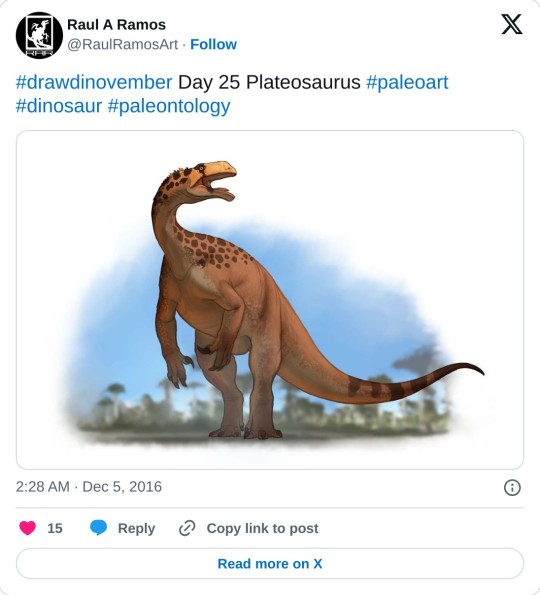
#pleistocene pride#pliestocene pride#mesozoic#dinosaur#dinosaurs#sauropod#prosauropod#sauropodomorpha#plateosaurs#dragon#triassic
5 notes
·
View notes
Text

Path of the sauropods 1: Plateosaurus
#plateosaurus#prosauropod#vector#vectorart#illustration#paleoart#art#paleoillustration#vectorillustration#adobeillustrator#dinosaurs
27 notes
·
View notes
Text
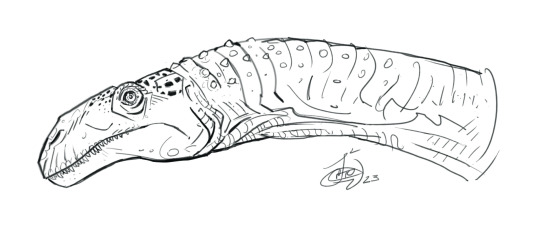
A prosauropod giving me the side-eye. Well technically they are always giving the side-eye; if you've ever spent some time around one, you'll notice that the eyeball never turns in its socket. Most critters can't; that's why you see little to no whites of the eyes in most non-mammal creatures. They have this wreath of small bones called the sclerotic ring embedded in the eye that locks them in place. Predators are usually locked pointing more to the front, prey usually locked pointing more to the side. If a creature with sclerotic rings wants to change their angle of view, they've got to rotate their neck. So yeah; that's why the perpetual side-eye expression.
Even though Prosauropods had a mixed diet of meat and plants, they always seem to me to be giving more of a side-eye than other prey critters. It's something about their expression; they always seem stressed out. And boy do they startle easily, like they're wired up on caffeine and spooky bedtime stories. Which is odd, because the first coffee shop wouldn't show up for another 210 million years.
148 notes
·
View notes
Text
Aardonyx

Aardonyx is a basal sauropodomorph with many intermediate features between prosauropods and sauropods. It grew to about 6 m in length, and was facultatively bipedal. This means that it would normally walk on two legs, but could move on all fours as well. Its jaws also bear transitional features. They are more narrow than more derived sauropods, but seem to indicate sauropod-like reduced cheeks. This unusual combination of features suggest feeding behavior transitioning toward the bulk-browsing common in later sauropods.
79 notes
·
View notes
Note
honestly Sauropoda should've been defined as everything closer to Cetiosaurus than Megalosaurus or Iguanodon, that way we wouldn't have to use the accurate but cumbersome "non-sauropod sauropodomorphs", or the paraphyletic "prosauropods" to refer to sauropod relatives from before the arbitrary cutoff point, we could just call them all sauropods
yeaaaaaaaaaah taxonomy is a field riddled with major mistakes
17 notes
·
View notes
Text
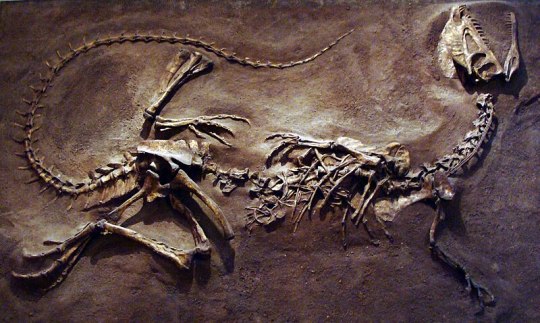
Name: Dilophosaurus wetherilli
Debut: Real Life, Circa The Early Jurassic (roughly 280 million years ago)
Hi I'm gonna talk about my favorite dinosaur now and you're gonna like it! Or maybe you won't, I don't know you! But y'know what I do know? Dilophosaurus!!! It's my best friend. They named it after the fact that it's got two (di) crests (lopho) on its head and also it's a reptile (saurus). A big reptile at that! In fact, it was the largest known animal of its time to walk the land in North America, and was almost certainly the apex predator of its environment, the Kayenta Formation (located across several of what are now the South-Western United States).

As you can see, this size chart demonstrates that the largest specimen discovered was about 7 meters (23 feet) long; no Tyrannosaurus rex, mind you, but still far larger than... some popular depictions might lead you to believe.
Also contrary to what some popular depictions might lead you to believe, Dilophosaurus would not have required the use of various biological mechanisms such as, for instance, retractable neck frills or venom-spitting to take down its prey; mechanisms which, mind you, are exclusively seen in animals as methods of self-defense, and would therefore only serve to scare away potential prey items.
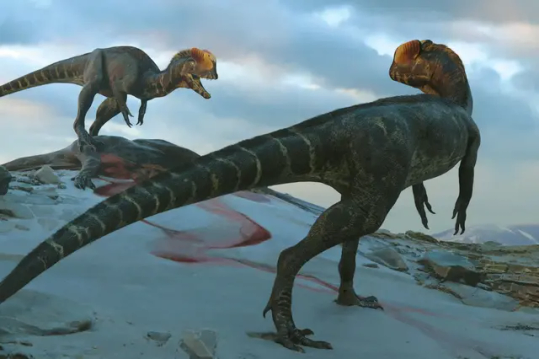
Speaking of prey items, this stunning piece by Chase Stone depicts a pair of Dilophosaurus as having just brought down a prosauropod (a name for early sauropod relatives). Dilophosaurus did in fact live alongside at least one prosauropod, Sarahsaurus, the Holotype specimen of which bears tooth marks very likely left by a certain two-crested culprit! On that note I want to address another prevalent misconception in regards to life reconstructions of this animal...
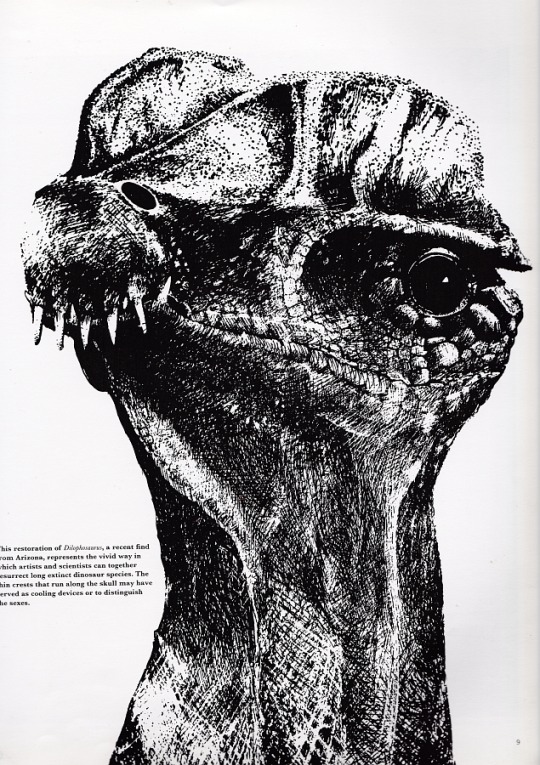
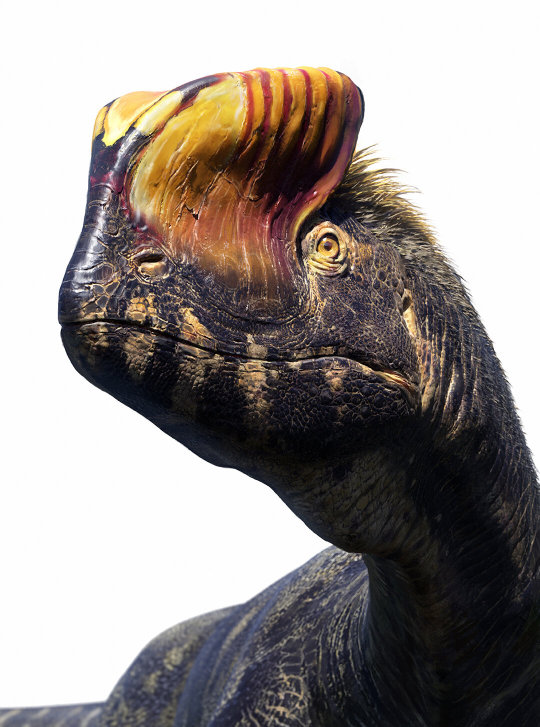
On the left we have a (frankly hilariously sock-puppet-like) restoration by a sadly unknown artist, and on the right is another absolutely breathtaking rendering by Chase Stone. As you can pretty clearly see, the way the crests (among other things) are restored is very different between the two! For a long time, the crests were restored as seen on the left: very thin, and with a little protrusion jutting out of the back. This is due to something called shrink-wrapping, a trend in paleoart exemplified by the omission of tissues such as muscle or fat when reconstructing the animal, leading to much of the skeleton being visible through the skin, particularly in the case of the skull.
Stone's restoration, on the other hand, wraps the skull in a much more naturalistic-looking amount of soft tissue, and completely envelops both crests in a keratinous structure, much like the casque of a cassowary or a hornbill (in fact I believe the coloration is actually referenced specifically from a knobbed hornbill's beak).
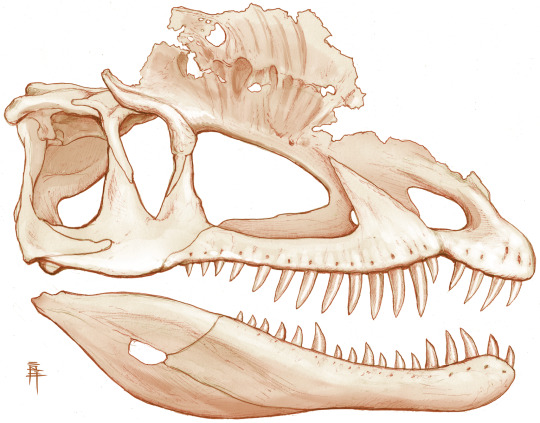
This is due to the fact that the crests were likely a kind of bony core which would have supported a larger keratinous structure as is to be expected of... sigh... horny structures such as this. Stop smiling. Don't you know there's no fun allowed when you're learning about things? That's what school taught me, anyway. Ahem. As I was saying, the original shape of the crest was extrapolated from incomplete remains, which you can see a restored illustration of above.
Also worth noting is the inclusion of a thin, fluffy covering of feathers along the head, neck, and back of Stone's restoration. This is entirely plausible, as the current consensus is that dinosaurs and their close relatives, pterosaurs, were descended from a fluffy common ancestor due to the fluffy-feathery coverings seen in both groups being found to be basically the same stuff!

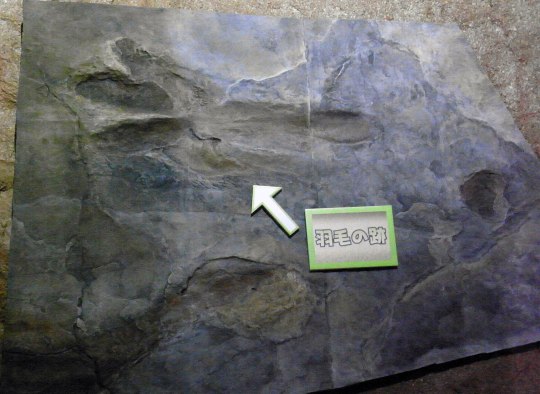
I could go on about so many things, like how tremendously fucked up and addled with tumors and infections the Holotype specimen was, or how we have a trace fossil which seems to preserve a Dilophosaurus sitting down in the mud like a big dumb bird, complete with an impression of its butt, but I trust that if these things pique your interest enough, you'll seek them out on your own time. Just remember not to have fun, because as we all know, fun is the one thing learning should never be.
59 notes
·
View notes
Text

More work from my spec evo project, Saurian Archipelago.
Finished my first concept sheet volume of creatures from the northern highlands of the Saurian Archipelago.
Dromeaolestes ermes
The arid adapted species of the genus Dromeaolestes and a descedant of Compsognathus. Its small size allows it to run around the rocky regions of the highlands undetected, usually scavenging the kills of larger predators without notice. A frenzy between the ermes species can occur if the smell of rotting flesh is picked up upon, as these rat-like theropods love to dine on maggots and other pestering insects.
Saurdios
The largest dinosaur in the archipelago chain and a descedant of early sauropodmorphs. It has a giant neck sac which inflates to scare off predators like Dynamosaurus or others of its kind. This prosauropod is also capable of rearing up on its strong hind legs, such a pose is fear-inducing to anything in its general location as the incoming impact can knock smaller creatures off balance.
Agathaumas
The behemoth descedant of very primitive ceratopsians such as Aquilops. It has quite a territorial temper, lashing out against most creatures that walk near it, such a temper is necessary for its survival against others of its kind and the massive apex predators of its region. A bizzare sail like structure can be seen on its tail, these are actually scale extensions which also serve as a display structure to utilize in a multitude of situations.
Arbator
A man-sized descedant of Deinonychus, specialized as a pursue predator with the capacities to run across long distances with enduring pace. This dromaeosaur's ash-like feathering helps hide it within shade, both to ambush prey or to hide from competition in the region, as Arbators are quite agressive to eachother. Arbators usually have red tinted regions on their body, in most cases their feet, which originates from kicking up the red dust in the region. If a Arbator has a lot of red tint on its body, it shows off the amount of experience they have wandering the arid highlands.
#art#artwork#artists on tumblr#dinosaur#colorful#paleoart#doodle#concept art#design#dinosaurs#paleontology#speculative biology#spec evo#speculative zoology#speculative evolution#speculative fiction#worldbuilding#lost world#retrosaurs#creature design#character art#creature#original creature#creature art#prosauropod#saurian archipelago#dromeosaur#ceratopsian#triceratops#deinonychus
138 notes
·
View notes
Text
A Hundred Some New ATOM Kaiju Pt. 10
On this installment of the unfinished ATOM kaiju showcase, we have an extended Ultraman reference.
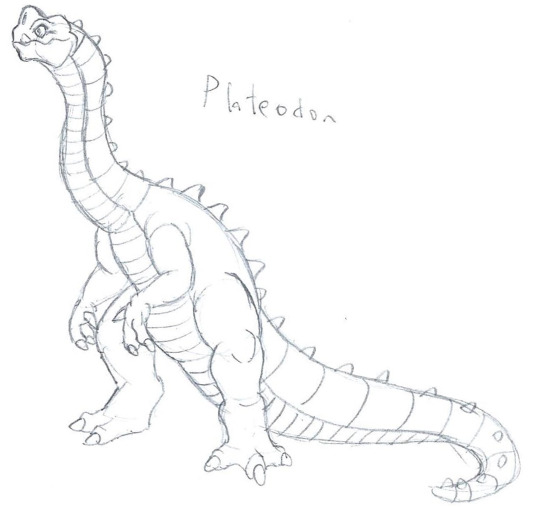
Meet Plateodon, a retrosaur kaiju loosely inspired by prosauropods/plaeteosaurs. Not particularly notable on its own, right?
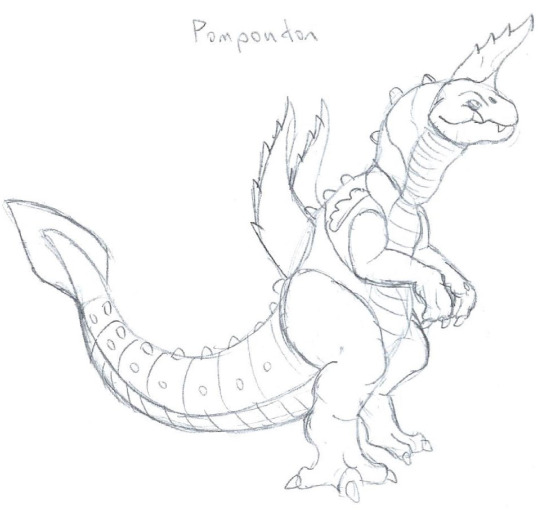
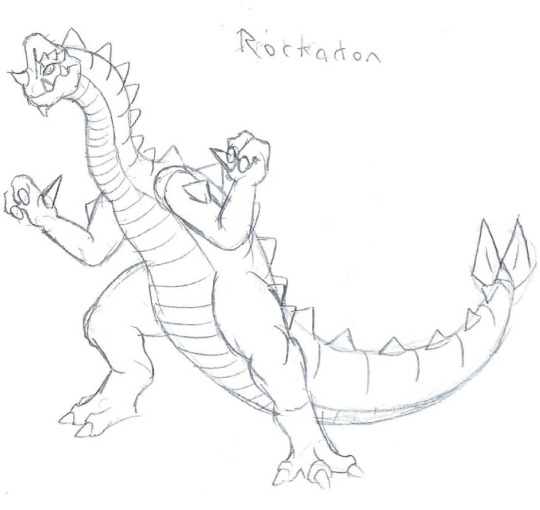
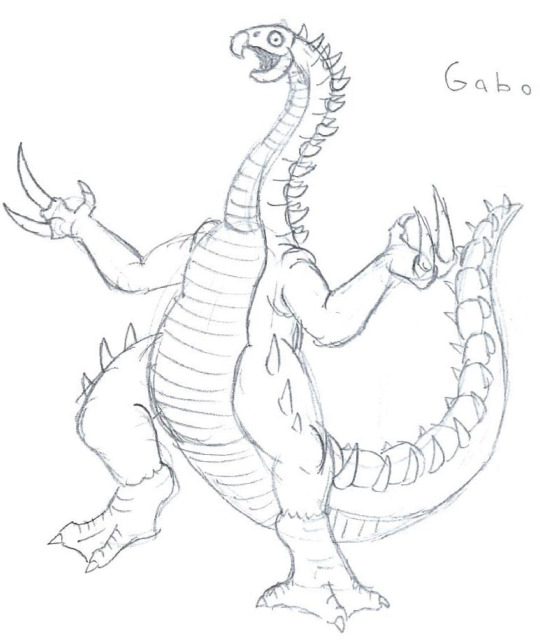
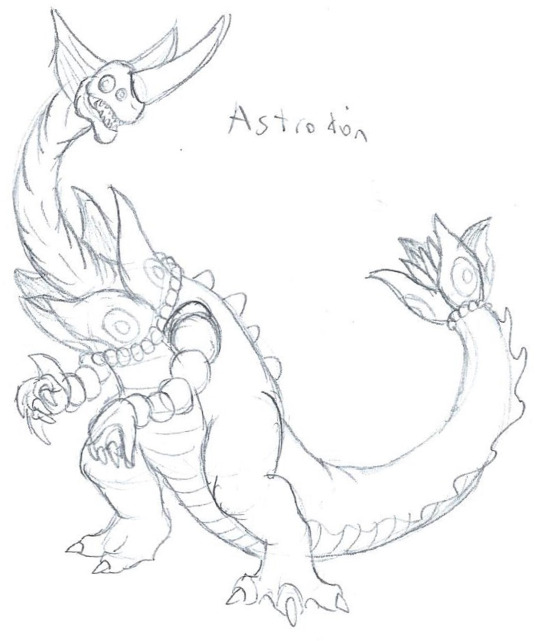
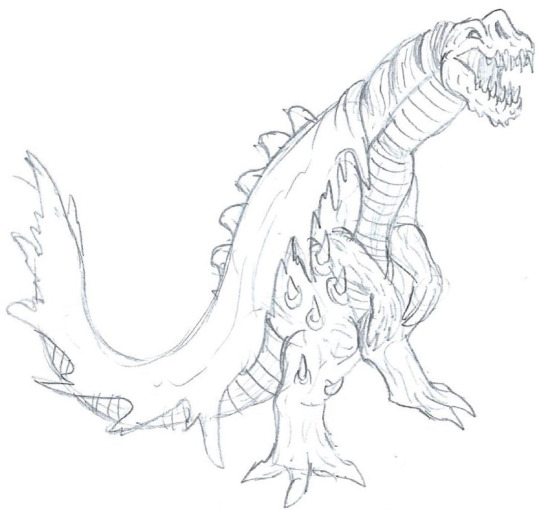
On my kind-of-defunct discord server, I held a short challenge of sorts for people to design kaiju with the caveat that they were "recycled from Plateodon's suit," the way that a lot of Ultraman kaiju are made of parts from other Ultraman kaiju to save on construction costs. In other words, if Plateodon is Baragon, I wanted to see the Neronga/Pagos/Gabora/Magular.
None of these guys are direct adaptations of the kaiju my friends created, but rather mixed and matched various ideas that were generated by that challenge to make a distinct set of recycled plateodons, with the final one explicitly playing with the idea that it was made from the suit after it was thoroughly rotted, torn, and beaten up by the constant reuse - a Plateodon recycle used for Redman, if we want to be real silly with it.
It kind of makes these guys kin to the Contest Entry kaiju, I suppose - they've got more of my design input in them than the Contest kaiju do, but there's still a good bit of outside design influence too. It's a fun set.
22 notes
·
View notes
Text
Spectember 2023 #06: Some Big Reptiles
An anonymous request asked for a "large ankylosaur-like herbivorous notosuchian":
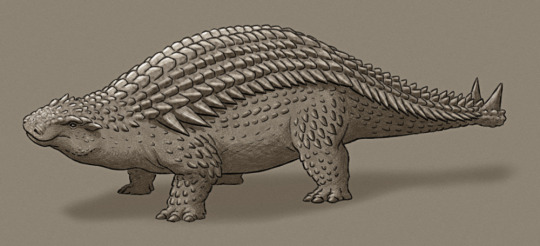
Mitafosuchus pachysomatus is descended from Simosuchus-like notosuchians in Madagascar that survived through the K-T extinction.
Highly convergent with the now-extinct ankylosaurs, it's a 5m long (~16'4") squat tank-like herbivore with hoof-like claws, and a wide short snout used for grazing on low vegetation. Heavy interlocking osteoderm amor covers most of its body, protecting it against the big carnivorous crocodyliformes that also still survive in this version of Cenozoic Madagascar.
———
Another anon wanted to see a "giant warm blooded lizard":

Atopohippus zestamenus is a descendant of invasive Argentine giant tegu lizards that became established on an island archipelago. At 2m tall (~6'6") and around 6m long (~20') it's an example of island gigantism, and occupies a high-browsing-herbivore ecological niche similar to giant tortoises and prosauropods.
Its ancestors' seasonal endothermy has become full endothermy in this species, partly due to young individuals having a very rapid growth rate and metabolism – their main defense against the predators on their island home (primarily carnivorous tegu-descendants and large birds of prey) is to simply get to a big body size as fast as they possibly can.
#spectember#spectember 2023#speculative evolution#notosuchia#crocodyliform#pseudosuchia#tegu#squamata#lizard#reptile#art#science illustration
272 notes
·
View notes